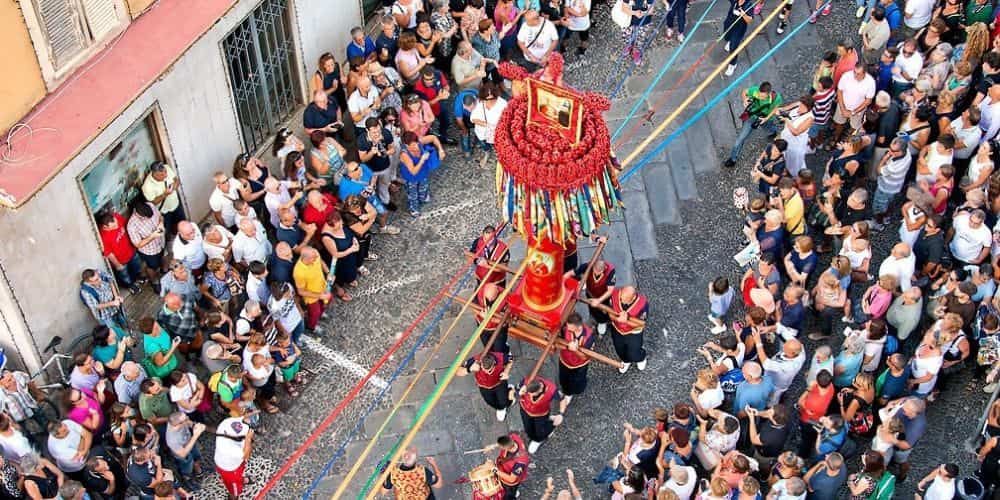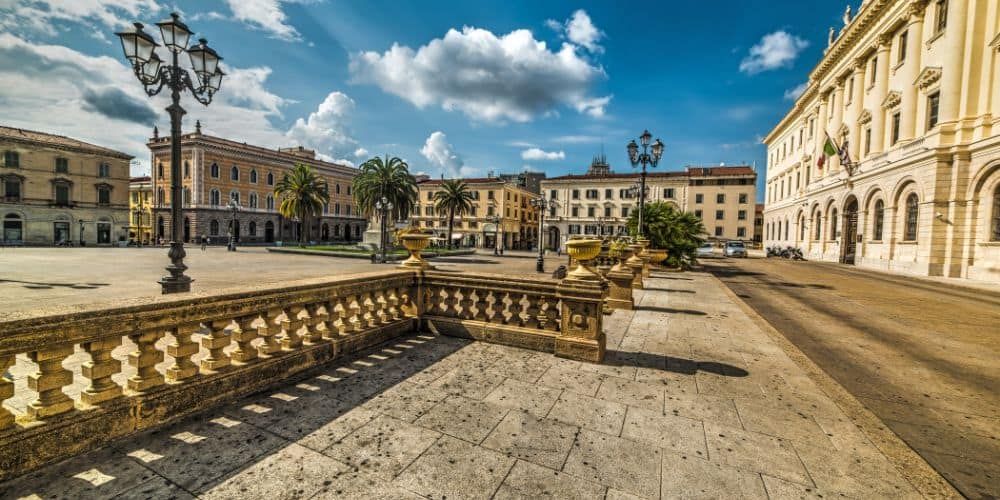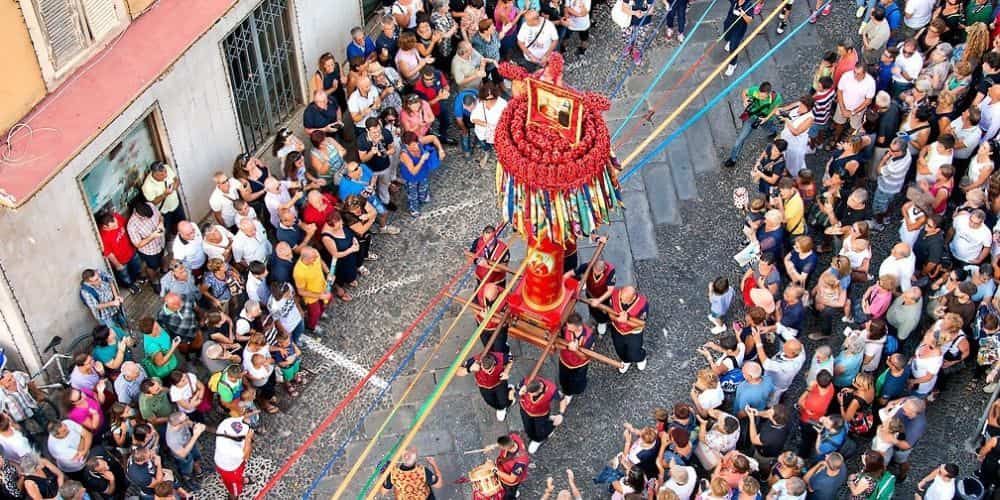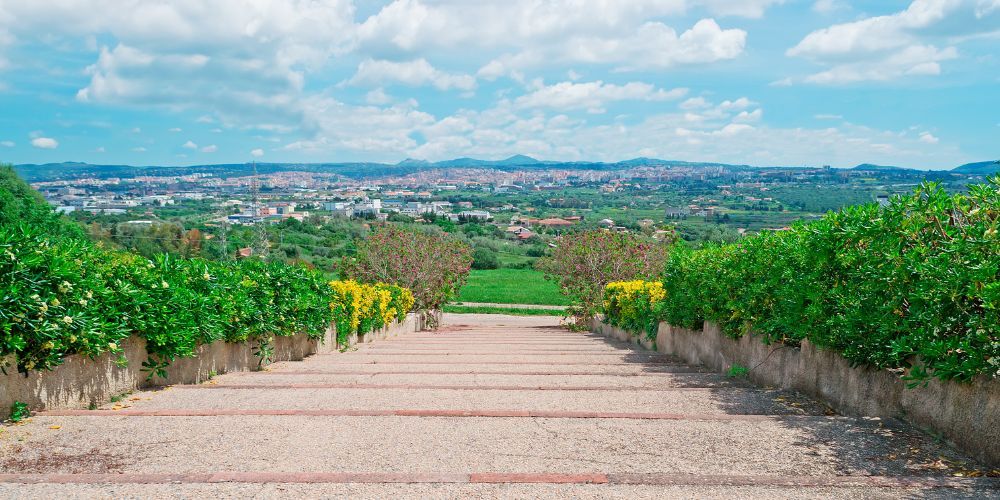Traditional festivals and rituals are characteristic of an Italy that wants to keep alive those customs handed down for centuries, proudly re-proposing them every year, involving the local population and attracting tourists. The city of Sassari, with its March of Candelieri, is the perfect example of how important and shared the feeling of authenticity is in Sardinian culture.
The Faradda of Sassari is five centuries old and does not show it: it attracts thousands of visitors every year and its charm captivates every person who attends the event. It is part of the Network of Great Italian Shoulder Machines and has been included in the UNESCO Intangible Cultural Heritage of Humanity since 20213. We reveal what makes this festival magical: 5 things you don't know to fully enjoy an unforgettable experience!
Translated with DeepL.com (free version)

Religious festivals in Sardinia: the March of Candelieri is a living tradition

The March of Candelieri is one of the traditional festivals that makes Sardinia an even more fascinating region. These events are the lifeblood of Sardinia's cultural heritage, which is passed down from generation to generation, transmitting the customs and values that characterise the sense of belonging of the various local communities.
They represent a bridge between past and present, an opportunity to rediscover the roots of this territory and enhance them, proudly showing tourists from all over the world the history and identity of a region rich in enchanting natural resources. This festival will also allow you to get closer to Sardinian culture and experience unforgettable emotions. Don't miss all the opportunities that Sardinia offers throughout the year, discover them all with the Salude & Trigu programme. Are you ready to share a historical event? We reveal 5 things you don't know about the Faradda di li Candareri.
5. The March of Candelieri takes place in Sassari

The Candelieri event in Sassari, despite being born for a religious occasion, is a moment of joy and sharing that involves the whole community. The streets are filled with colour and joy and there are side events that increase the opportunities for fun. It will be an opportunity to stroll through the streets of the historic centre, discovering the noble palaces and baroque churches that embellish the city.
In the weeks leading up to the evening of the March of Candelieri, in Sassari you will be able to attend traditional music concerts and folklore shows and visit craft markets where you can taste typical local products and learn about local gastronomy. In particular, it will be fascinating to follow the events of the Piccoli Candelieri and the Medi Candelieri, organised to introduce the youngest to this important tradition. The weight of the candles is in proportion to their age, but the religious feeling and atmosphere are certainly impressive. The Faradda di li Candareri event officially ends at the end of the month, when the candlesticks are returned to their seats and remain in custody until the following year.
4. The Candelieri event is one of the most spectacular events in Sardinia
The event, in Sassari dialect Faradda di li Candareri, has always been held on 14 August: it is a ritual that pays homage to Madonna dell’Assunta (our Lady of the Assumption), to thank her for having freed the city from the plague. The event animates the streets of Sassari, with a procession in which candlesticks are carried on the shoulders. These are decorated wooden structures that have a deeply religious significance.
Originally, candles were used for the festival, but over the centuries they were replaced by wooden machines that cost less. The Gremi, which are the descendants of the ancient guilds of arts and crafts, then parade with wooden columns topped by flags. Each guild offers its speciality, which is precisely a qualification: they can be blacksmiths, butchers, farmers, carpenters, all ancient trades handed down over the centuries. In the course of the year, the Gremi are also celebrated individually on the occasion of their personal patron saint.
3. The Faradda di li Candareri is one of the festivals with a machine on the shoulder

The March of Candelieri is one of the few Italian festivals in which the procession takes place by means of the ‘macchina a spalla’, i.e. the hand-carrying of imposing sacred structures by the faithful. A similar system is envisaged in the Gigli Feast of Nola, but the Nola lilies are smaller and lighter than the Candlesticks of Sassari. On both occasions, however, there are moments of great spectacle, with songs, music and traditional costumes creating a unique and enthralling atmosphere.
The bearers have an onerous physical task, that of parading with a weight of about four quintals, reaching a height of three metres. Usually eight people are chosen who are able to advance in synchrony. During the procession, the mayor and town councillors also join in and proceed to the church of St Mary of Bethlehem, where the convent's guardian father gives his blessing and renews the vow to the Assumption. The traditional greeting ‘A zent'anni!’ concludes the parade.
2. It is celebrated in honour of Madonna dell'Assunta: discover the religious meaning of the e
The Faradda di li Candareri is first and foremost a manifestation of deep faith and devotion to Our Madonna Assunta, which retains a profound value in popular tradition. It originated with a vow, the promise to carry votive candles every year, and is proposed as a very intense and enthralling moment of spiritual recollection. The lit candles become the symbol of the soul's ascent to heaven. Tourists participating in the event find themselves in a magical atmosphere that leaves unforgettable emotions.
The preparation of the event is well structured and includes certain steps that are historical. During the morning of 14 August, the candelieri are decorated and decked out to be the real stars of the festival. In the evening, the candlesticks meet in Piazza Castello and from here the procession through the streets of the old town begins. The gremi carry the candle characteristic of their trade and one of them has the task of holding the banner of his gremio. The procession is accompanied by prayers and religious chants that emphasise the sacredness of each moment, and everything is experienced in communion, overcoming all social divisions: the hard work of the people who work for months flows into a spectacle under the banner of solidarity, with the aim of making all visitors share in the feelings.
1. It involves the whole community and invites you to get to know the city and its surroundings

If you have chosen to take part in the Candelieri procession, you can plan a trip to experience other events in the area at the same time. These are traditional festivals that will bring you closer to the local culture and leave unforgettable memories. On 30 July and 9 August, you can attend the 10th Edition Melos Festival, while the Festival of Our Lady of the Good Way will be held on 11 August. If you are going to be around at the end of July, you cannot miss the Ciogghitta d'Oro organised on 25 July, a very special culinary event where tasting is associated with moments of general goliardia.
Besides these festivities, you can visit some of the most beautiful beaches in North Sardinia and find your moments of serenity and relaxation that should never be missing in a holiday. Let yourself be won over by Sardinian hospitality, taste the authentic flavours of the local cuisine and take a piece of this fascinating land with you. If you have time, take an excursion inland to discover medieval villages and unspoilt landscapes. Sassari awaits you with its thousand faces, ready to give you an experience rich in emotions, culture and natural beauty.
About the author
Written on 08/08/2024


Barbara Giuliani
Live a unique experience and immerse yourself in the atmosphere of the March of Candelieri, a World Heritage Site that will leave you speechless.